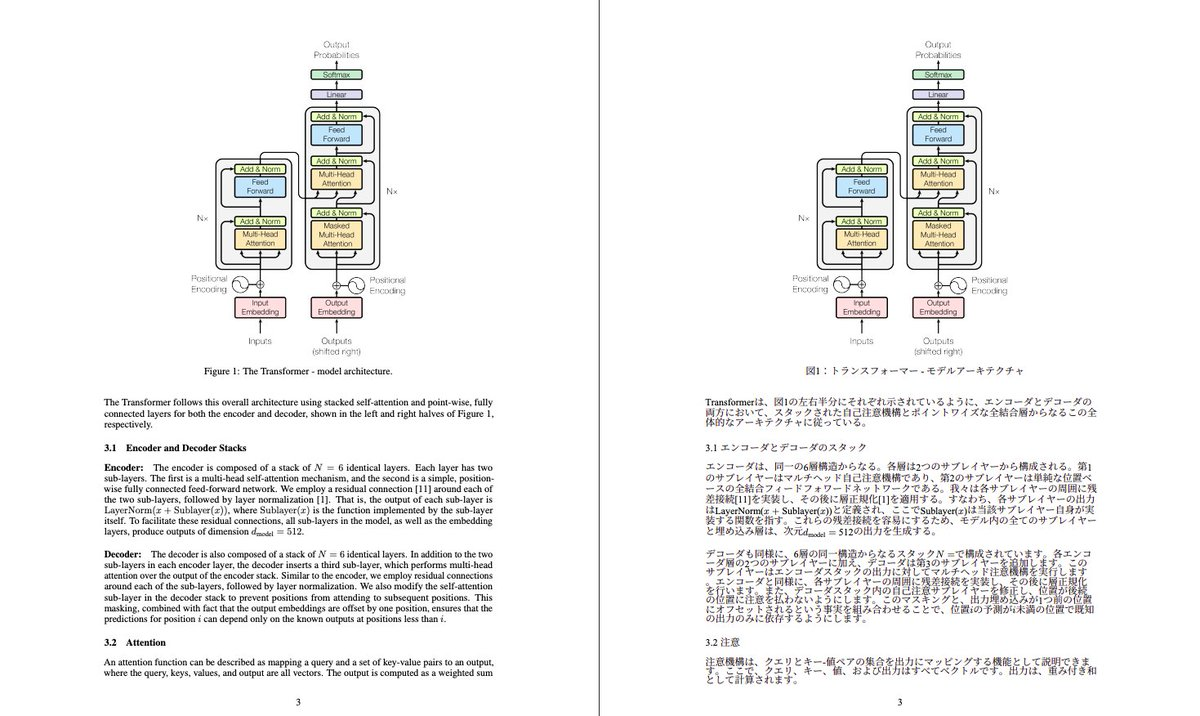PLaMo Integrated PDFMathTranslate
For papers I want to read quickly, Japanese is preferable, so I had Claude Code create this tool.
When you input an English PDF, it outputs a Japanese PDF and a bilingual (Japanese/English) PDF.
It runs PLaMo translate locally using mlx-lm.
This is for Mac, but it works on other OSes by changing the inference part using mlx-lm.
Memory usage is around 6-10 GB.
Tested on macOS Sequoia 15.4.1, M4 MacBook with 16 GB memory.
Source code:
https://github.com/shogo-d-nakamura/PDF-PLaMoTranslator
Examples are shown in run.sh.
Create a venv environment with zsh install.sh, download PLaMo translate with python DL_plamo_translate.py, then specify the PDF or directory containing PDFs you want to translate with -i as shown in run.sh.
When specifying a PDF file (article.pdf), it outputs article-out.pdf and article-dual.pdf.
When specifying a directory (articles), it creates articles-out/ and sequentially outputs {$PDF_FILENAME}-out.pdf and {$PDF_FILENAME}-dual.pdf.
1
2
3
4
5
| # for PDF
python translate.py -i ~/workspace/PLaMoTranslator/article.pdf
# for batch translation
python translate.py -i ~/workspace/PLaMoTranslator/articles
|
Below is the Japanese translation of the README created by Claude.
Quick Start
1. Install Dependencies
1
2
| # Create virtual environment and install PDFMathTranslate and MLX-LM
zsh install.sh
|
2. Download Model
1
| python DL_plamo_translate.py
|
3. Translate PDF
1
2
| # Test sample
python translate_test_pdf.py
|
This creates test-out.pdf and test-dual.pdf.
Features
PLaMo Integration Features
- Smart Token Management: Automatically chunks text into approximately 1024 tokens
- Sentence Boundary Preservation: Maintains sentence boundaries during chunking
- High-Quality Translation: Uses mlx-community/plamo-2-translate model
- Layout Preservation: Maintains original PDF format using PDFMathTranslate
Automatic Features
- Token Estimation: Estimates approximately 4 characters per token
- Error Handling: Proper fallback for translation failures
- Progress Tracking: Shows translation progress for large documents
- Format Support: Handles mathematical formulas and complex layouts
Usage Examples
Basic Translation Script
1
2
3
4
5
6
7
8
9
10
11
12
13
| #!/usr/bin/env python3
import sys
sys.path.insert(0, 'PDFMathTranslate')
from pdf2zh import translate
# Translate PDF using PLaMo
translate(
files=["input.pdf"],
output="./output",
lang_in="en", # English input
lang_out="ja", # Japanese output
service="plamo" # Use PLaMo translation
)
|
Command Line Usage
1
2
3
4
5
6
7
8
9
10
| # Navigate to PDFMathTranslate directory
cd PDFMathTranslate
# Translate using PLaMo service
python -m pdf2zh.cli \
--service plamo \
--lang-in en \
--lang-out ja \
--output ../output \
../test.pdf
|
Advanced Usage
1
2
3
4
5
6
7
8
9
10
11
12
13
14
15
16
| from pdf2zh import translate
# Custom configuration
translate(
files=["document.pdf"],
output="./translations",
lang_in="en",
lang_out="ja",
service="plamo:custom-model-name", # Use custom model
thread=1, # Single thread for PLaMo
ignore_cache=True, # Fresh translation
envs={
"PLAMO_MODEL": "mlx-community/plamo-2-translate",
"PLAMO_MAX_TOKENS": "1024"
}
)
|
Configuration
Environment Variables
Set the following environment variables to customize PLaMo behavior:
1
2
| export PLAMO_MODEL="mlx-community/plamo-2-translate"
export PLAMO_MAX_TOKENS="1024"
|
Model Configuration
1
2
3
4
5
6
| # Use different PLaMo models
service_options = [
"plamo", # Default model
"plamo:mlx-community/plamo-2-translate", # Explicit model specification
"plamo:custom-plamo-model" # Custom model
]
|
How It Works
Token Management Process
- Text Extraction: Extract text from PDF pages
- Token Estimation: Estimate token count (approximately 4 characters = 1 token)
- Smart Chunking: Split text at sentence boundaries
- Translation: Translate each chunk using PLaMo via MLX-LM
- Reconstruction: Recombine translated text while preserving layout
